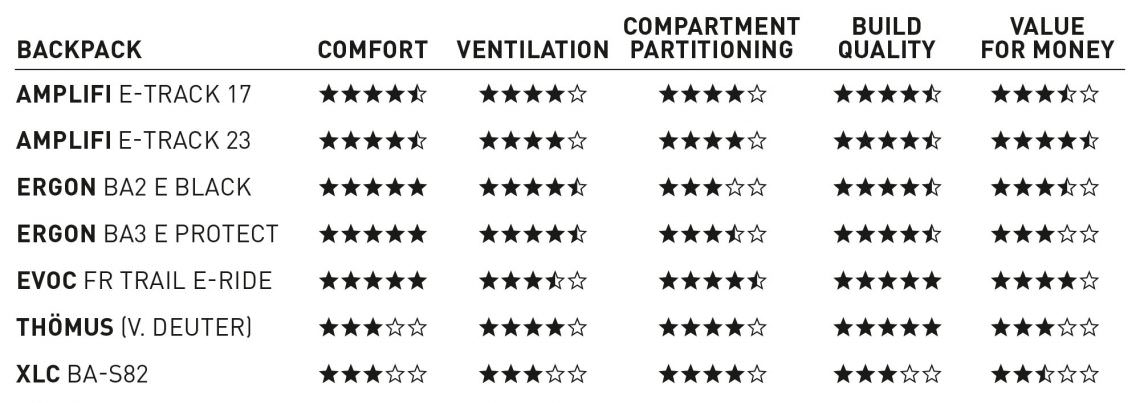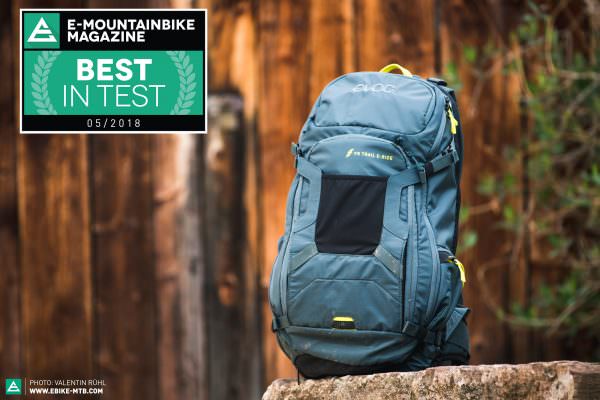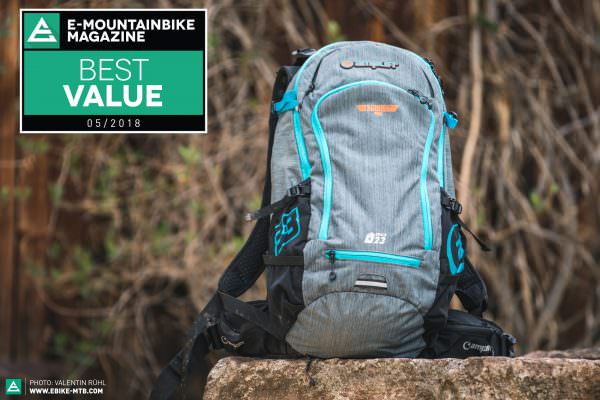It could be so perfect: you’ve got the whole of Saturday to yourself to ride your eMTB, but after three hours at most the battery is flat… what then? If you’re looking for a day of uninterrupted eMTB fun, carrying a spare battery in your backpack is the only solution. Therefore we tested the most promising eMTB specific backpacks for you.
Why would you need an eMTB backpack? The question is almost self-explanatory: the capacity of most batteries isn’t enough for very long rides. If you don’t want to waste time recharging, you’ll have to bring along an additional battery somehow. Of course, you could merely stuff the battery in a classic daypack, but an eMTB-specific backpack will keep the approximately three kg spare battery securely in a special compartment. Also, if you’re carrying something with the weight and dimensions of a brick in your backpack, you’ll be glad to know there’s a back protector between it and your spine.

In autumn 2016, AMPLIFI launched the world’s first ebike-specific backpack, the AMPLIFI E-Track 23. One year later they launched the E-Track 17, with a little less volume. Meanwhile, other manufacturers have caught on, also releasing backpacks with integrated battery compartments. This was reason enough for us to take a closer look at what’s on offer. Besides AMPLIFI backpacks, we put models from Ergon, EVOC, Thömus, and XLC to the test. We also experimented with two alternatives to carrying an extra battery in your backpack.

Caution: Not every battery fits in every backpack!
Everything was better in the old the days. Okay, not necessarily better, but a lot easier. For example, there was the post office, which was also responsible for the telephones. And in 2013, all eMTBs that we tested still came equipped with a Bosch motor. However, as early as 2014 we had our first test bike come with a Yamaha motor, as well as a different battery. In 2018 things have become even more complicated and the market is full of different batteries – from the flexible snake battery, which consists of individual segments, to the over 50 cm-long Specialized Levo battery, which only just, with some restrictions, fits into three of the biggest backpacks of this group test.

The backpacks on test
| Backpack | Price | Weight | Volume | Battery compatibility* |
|---|---|---|---|---|
| Amplifi E-Track 17 | € 200.00 | 1,473 g | 17 l | 1/2 |
| Amplifi E-Track 23 Tschugg LTD | € 200.00 | 1,608 g | 23 l | 1/2/3 |
| Ergon BA2 E Black | € 169.95 | 1,328 g | 10 l | 1/2 |
| Ergon BA3 E Protect | € 179.95 | 1,390 g | 15 l | 1/2 |
| EVOC FR TRAIL E-RIDE | € 220.00 | 1,460 g | 20 l | 1/2/3 |
| Thömus E1 Backpack | CHF 150 | 1,163 g | 16+3 l | 1/2 |
| XLC E-Bike Rucksack BA-S82 | € 149.00 | 1,503 g | 23 l | 1/2/3 |
*1 = Bosch & Shimano external
*2 = Intube batteries such as Bosch Powertube
*3 = Long, special batteries such as Specialized Levo

The Alternatives – Attaching the Spare Battery to the Bike
| Bag | Price | Weight | Volume |
|---|---|---|---|
| Topeak MidLoader 3L-Rahmentasche | € 39.95 | 250 g | 3 l |
| ORTLIEB Seat-Pack M | € 129.99 | 336 g | 11 l |



What makes a good eMTB backpack?
The basic features of an ebike backpack don’t differ from a regular bike backpack. Unique features include straps for the battery in the main compartment of the bag, as well as a spine protector. Except for the Thömus, all models in the test field come with a back protector.
The correct fit
The be-all and end-all of a backpack is the right fit. When riding your bike, it’s crucial that the centre of gravity is as close to the body as possible so as not to interfere with your riding – even at the cost of ventilation. Apart from perfectly formed back padding, the correct size of the backpack is also decisive so it doesn’t slide up your neck or against your helmet on descents, or swing around sideways. The size of the backpack should, therefore, be chosen to fit both body height and actual transport requirements. Some backpacks are offered in different sizes for different back lengths. Other backpacks, especially smaller ones, can be adjusted to different back lengths from S to XL using an intelligent adjustment system. Dry runs in a downhill position should give a good first indication of the fit.



Compartmentalisation
You should be aware of how much carrying capacity you need. Is a small daypack enough to store your essentials, or do you want to take a little more with you on your rides? You should choose the size in such a way that you have little space remaining in the backpack when filled; this will prevent the contents from flying around in their compartments. Even well-placed compression straps won’t be able to make a big backpack small enough if you’re not carrying enough for the intended volume. A well-compartmentalised storage space helps to keep everything neat and tidy, especially if it contains individual compartments for small items such as your glasses, tools, and energy bars. The compartment for a hydration bladder should be separate to keep it clear of sharp objects and make sure that it stays put.
Durability
Another topic is durability: a mountain bike backpack has no easy life – it has to withstand sweat, dust, mud, moisture, and sun. Then there’s the occasional crash, the constant opening and closing of zippers and buckles, and generally rough handling.

Comfort
The shoulder straps should distribute the load evenly over the shoulders. The hip and chest straps are indispensable to relieve strain on the shoulders and to secure the backpack to the body. At the hips, the straps should strike a good balance between narrow and wide, with proper padding, neither cutting in nor causing a build-up of heat. No matter how useful the functions of the backpack are, and how many compartments it has, if you start to feel hot spots and chafing after two hours in the saddle then the rest of the day becomes a pain.



Packing list for a day trip
To make the test as practical as possible, we compiled the following packing list, including the most important things for a day of riding, and we packed it into all of the backpacks we tested :
- mini pump
- tube and tire patches
- shock pump
- multitool with chain breaker
- spare chain link


Conclusion
Which backpack best meets all these requirements? The 15L Ergon BA3 E has enough space for most things, but unfortunately, its battery compartment is tiny and already reaches its limits with a Bosch PowerTube battery. The smaller version, the BA2 E, with 10L of volume, is aimed less at touring and more at riders who go on shorter rides with less baggage, and it only offers enough space for the compact external battery type. Unfortunately, we can’t recommend the Thömus E1 due to its lack of a back protector – the potential consequences of crashing with a battery in the back are too serious. The XLC BA-S82 ebike backpack is a promising option for frugal buyers, but sadly, it can’t compete with the best models in the test field regarding quality and features.


In the end, the pioneer, the AMPLIFI E-Track, and the EVOC FR TRAIL E-RIDE had to fight it out for the group test victory. The 20 € cheaper AMPLIFI E-Track 23 secures the coveted Best Value tip. The EVOC FR TRAIL E-RIDE won the group test with its outstanding workmanship, many practical details, and a very comfortable and secure fit.












